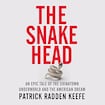
The first chapter of this book recalls the opening 20 pages of Henry David Thoreau’s 1865 classic Cape Cod, which describe how 145 emigrants from post-Famine Galway drowned when the brig St John was smashed on to Cape Cod rocks in a storm in October 1849.
The Snakehead begins just over 250 miles (412km) further south along the same shoreline when 300 undocumented Chinese migrants were dumped into the sea without life jackets after the ship that had carried them across the Atlantic Ocean was deliberately driven on to a sandbank close to New York in June 1993.
This merciless dumping of the Chinese migrants more than 100 yards offshore prompted one of the biggest rescue operations in New York’s history and it marked the single largest arrival of illegal immigrants in modern US history. The migrants were each being charged up to $30,000 by one of the most successful and reliable illegal immigration brokers, a “snakehead”.
China’s one-child policy, enforced by compulsory abortion and sterilisation, coupled with post-Tiananmen Square repression, caused what was called “a frenzy” to escape to the United States. A 1990 White House executive order that Chinese citizens already in the US should not be forcefully removed, while “enhanced consideration” be afforded to people fleeing the one-child policy, effectively gave undocumented immigrants “a free pass” to remain in the US while their asylum applications were being considered, causing a backlog of several years.
I’d been insured for just one week when I crashed into a shiny black BMW
Easter activities: 10 family-friendly days out and events to enjoy over the holidays
Hyrox, the soaring fitness trend: ‘You meet so many different people, all shapes, all sizes’
The Last of Us review: Prepare to be shocked by this compelling new season
Snakeheads became enormously wealthy as the Chinese population in New York grew more than tenfold. When airline security tightened, the snakeheads bought ships and when the direct route across the Pacific became too risky, they took to sending ships “the wrong way around”, via the Indian and Atlantic Oceans.
By 1993 the New York Times was warning of “a new boomtide of political asylum seekers that is swamping the process”. It assigned 24 reporters to the story of the 300 migrants who scrambled on to Rockaway Beach off Brooklyn and Queens when their ship was deliberately grounded. The “swamping” fear reflected a changed public mood and it was shared by the New York head of the Immigration and Naturalisation Service, Bill Slattery. Asked about the rescued migrants by a White House National Security Council adviser as he sped towards Rockaway Beach, Slattery declared: “I’m going to lock them all up.”
Ten of the migrants died in the water or when they were brought ashore. Only 14 were granted asylum promptly. The remainder were deported or imprisoned for years awaiting asylum or parole. Some of those deported returned to the US illegally, preferring to be in the US illegally than to be in China legally.
[ 253 people, 253 stories, 253 words each: The re-creation of an internet novelOpens in new window ]
[ My Fourth Time, We Drowned: A book of evidenceOpens in new window ]
US law enforcement agencies hunted the snakeheads through Canada, Asia, Africa and Central America, while the rescued migrants were detained in legal limbo. The most notorious snakehead was deported from Hong Kong to the US in 2003. She died while serving a 35-year prison term. Mourners at her funeral in New York’s Chinatown called her a Robin Hood and “a living Buddha”.
People smuggling (as distinct from “people trafficking”) is now a $20 billion business, second only to drug smuggling among illegal enterprises. It is said to be the fastest-growing international crime. Some 75 per cent of the world’s migrants end up in 12 per cent of countries. Up to 40 million of the world’s estimated 200 million migrants are believed to be undocumented, including 12 million in the US. The more than 300,000 people in custody in the US awaiting asylum or deportation constitute the fastest-growing cohort incarcerated there.
This book was first published in the US in 2009. Its publication now on this side of the Atlantic coincides with Europe’s ongoing migrant situation and follows the author’s more recent, award-winning books on the IRA murder of Jean McConville (Say Nothing: A True Story of Murder and Memory in Northern Ireland) and on the family whose enormous wealth derived from the legal prescription drug OxyContin (Empire of Pain: The Secret History of the Sackler Dynasty). US reviewers have likened The Snakehead to The Sopranos and The Godfather, but it has more in common with the current An Post Irish Book of the Year, My Fourth Time, We Drowned, Sally Hayden’s account of the obstacles facing African migrants seeking refuge in Europe.
The Snakehead is a timely, powerful and thoroughly-researched book. What lingers from it are the remarks of New York Mayor David Dinkins after he had surveyed the dead and the barely-alive on Rockaway Beach: “These are people who are desperately trying to come to America. I would hope that those who are already here would recognise how important the freedom is that they have here.”














